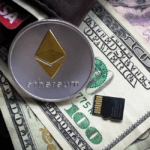The Ethereum blockchain—long hailed as the world’s most prominent smart contract platform—has entered a new chapter with the successful implementation of the Dencun upgrade. Rolled out in early 2025, Dencun is more than just a routine network update; it’s a pivotal moment that significantly enhances the user experience and marks a critical step in Ethereum’s …
Ethereum After Dencun: What the Upgrade Means for Users

The Ethereum blockchain—long hailed as the world’s most prominent smart contract platform—has entered a new chapter with the successful implementation of the Dencun upgrade. Rolled out in early 2025, Dencun is more than just a routine network update; it’s a pivotal moment that significantly enhances the user experience and marks a critical step in Ethereum’s long-term roadmap toward scalability, affordability, and mass adoption.
But what exactly does the Dencun upgrade bring to the table? And more importantly, what does it mean for developers, users, and the broader Ethereum ecosystem?
Let’s dive in.
🧱 What Is the Dencun Upgrade?
Dencun is a portmanteau of “Deneb” (the consensus layer upgrade) and “Cancun” (the execution layer upgrade). These dual-layer updates work together to address Ethereum’s most pressing issues—chief among them, high gas fees and limited transaction throughput.
At the heart of Dencun lies a game-changing feature called “proto-danksharding,” introduced via EIP-4844. This proposal paves the way for full danksharding by enabling “blobs”—a new data structure optimized for Layer 2 scalability.
If that sounds technical, here’s the big idea:
Blobs reduce the cost and complexity of posting large batches of transaction data to Ethereum, especially for Layer 2 rollups. This unlocks faster, cheaper, and more efficient transactions for users without compromising Ethereum’s security.
🔑 Why Proto-Danksharding Matters
To appreciate Dencun’s impact, you first need to understand how Ethereum’s Layer 2 rollups like Arbitrum, Optimism, and Base function.
Rollups batch hundreds (or thousands) of off-chain transactions and post a summary of those transactions to the main Ethereum chain. This allows users to enjoy low fees and high speed while still benefiting from Ethereum’s security guarantees.
Before Dencun, these rollups had to store transaction data directly on Ethereum’s call data—an expensive and inefficient process. With proto-danksharding and the introduction of blobs, rollups now have a cheaper, temporary space to post their data.
Benefits include:
- ⚡ Massive reduction in Layer 2 fees
- 🌐 More seamless user experience for DeFi and NFT apps
- 🔐 No compromise on decentralization or security
In other words, Ethereum just got a lot more scalable—and a lot more affordable.
💸 What It Means for Users: Real-World Impact
For everyday users, the effects of Dencun are already starting to show, especially on Layer 2 networks.
1. Lower Transaction Fees
If you’ve ever bridged assets to Arbitrum or Optimism and paid $1–$2 per swap, you’ll be pleased to know those fees are dropping significantly—in some cases, by over 80%.
Thanks to blob space, rollups are saving money on data availability costs—and passing those savings on to you. Expect to see average Layer 2 transaction fees around $0.01 to $0.05, making DeFi, gaming, and NFTs more accessible than ever.
2. Faster Confirmations
With more efficient data handling, rollups are also speeding up their block times, leading to smoother user experiences. That’s crucial for Web3 apps that require real-time feedback, such as on-chain games or decentralized exchanges.
3. Cheaper NFT Minting and Trading
Gas wars on the mainnet may soon become a thing of the past. Dencun enables cheap, high-throughput NFT activity on rollups, allowing artists and collectors to mint and trade NFTs with minimal friction.
4. Greater Accessibility for Emerging Markets
In places where $5 transaction fees represent a significant barrier to entry, Dencun’s cost savings open the door to wider global participation in crypto. This is especially important in developing countries where Ethereum-based apps are used for remittances, identity verification, and DeFi banking alternatives.
🛠️ Developer Perspective: New Tools, New Possibilities
Dencun isn’t just a user-facing win—it’s a developer milestone too.
- Blob transactions give dApp developers and rollup builders a powerful tool for efficient data handling.
- The EIP-1153 and other included proposals optimize transient storage, improving gas efficiency and making smart contracts leaner.
- Developers can now build more responsive, lower-cost applications that don’t have to sacrifice composability or decentralization.
We’re likely to see a boom in application-specific rollups, especially for sectors like gaming, real-world assets (RWA), and tokenized finance. Ethereum’s modular design, bolstered by Dencun, enables vertical scaling in ways previously impossible.
🔮 What Comes Next: Toward Full Danksharding
While proto-danksharding is a major leap forward, it’s not the endgame. Dencun sets the stage for full danksharding, which will eventually allow Ethereum to process hundreds of thousands of transactions per second by splitting the network into parallel shards.
The long-term vision includes:
- More blobs per block
- Longer data availability windows
- Greater throughput for Layer 2 and 3 solutions
This is a gradual, but transformative path, moving Ethereum from a congested superhighway to a multilane expressway built for mass global usage.
📈 Market Sentiment: Confidence Reignited
The crypto market has responded positively to Dencun. Ethereum’s price saw a healthy uptick following the upgrade, buoyed by:
- Renewed developer interest
- Strong rollup activity
- Institutional confidence in Ethereum’s long-term scalability
Analysts expect the post-Dencun Ethereum ecosystem to outperform alternative L1s due to its unmatched security, decentralization, and modular scalability.
💬 Final Thoughts: Ethereum’s Reinvention Is Just Beginning
With Dencun, Ethereum is not just patching its scalability issues—it’s reinventing itself for the next generation of the internet.
It’s easy to overlook protocol upgrades as technical jargon meant only for developers. But make no mistake: Dencun is a milestone for everyone—users, builders, and investors alike. It brings Ethereum closer to its dream of being a universal settlement layer for everything from DeFi and identity to games and governance.
As proto-danksharding becomes danksharding, and Layer 2s mature into robust ecosystems, Ethereum is primed not just to survive—but to lead.
Welcome to the next era of Ethereum.







